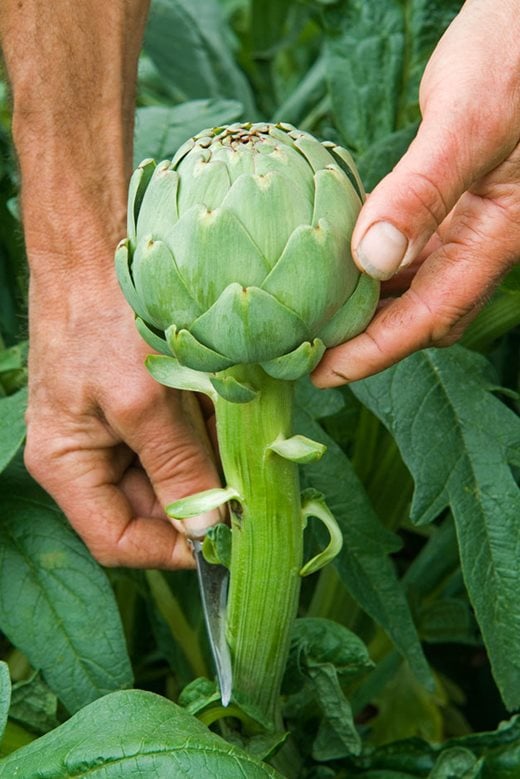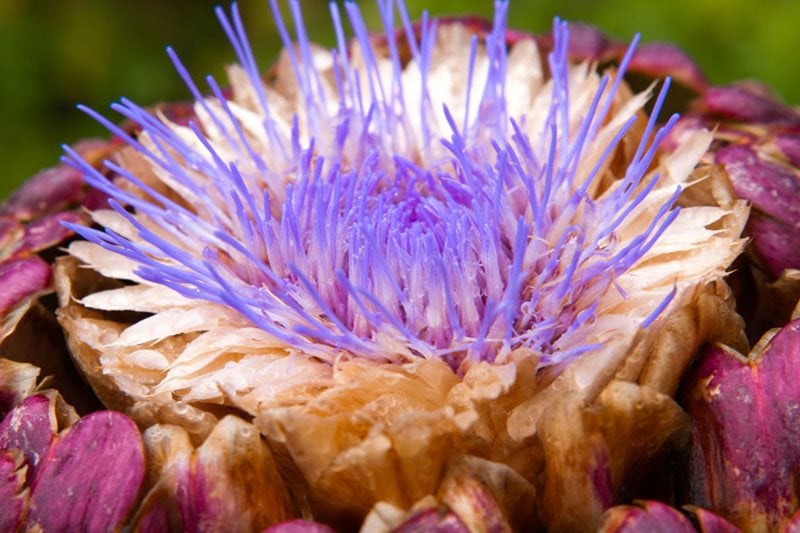As beautiful as they are delicious, globe artichokes make a long-lived and dramatic addition to the vegetable garden
 Botanical name: Cynara scolymus
Botanical name: Cynara scolymus
Origins: The globe artichoke is a cultivated descendant of the wild cardoon
First cultivated: Philosopher and botanist, Theophrastus, reported the cultivation of artichokes in Sicily during the 3rd century BC
Types: There are numerous green varieties (such as the popular ‘Green Globe’) as well as purple varieties available. Despite its name, the globe artichoke bears no relation to the Jerusalem artichoke.
Skill level: Easy
Preferred location and conditions: They prefer an open, sunny site with fertile, well-drained soil.
Harvest time: June to September. Cut as soon as the buds reach their full size and before the bracts start to open.
Planting and growing: Sow seeds indoors from March to April in 7.5 cm pots, harden off in May and plant out in June when the plants are large enough to handle, making sure they have plenty of space between them (90cm is ideal). Divide the plants every two to three years to keep them vigorous. Mulch the plants well in the spring and be sure to water them well during dry weather.
Possible problems: Slugs and snails can be a problem with young plants, so try using beer traps, coffee grounds or egg shell barriers to keep them away.

Did you know?
Native to the Mediterranean, the globe artichoke is actually the edible flower bud of a cultivated thistle, which perhaps goes some way to explaining the prickly response it elicits in some people. For not only does the artichoke owe its very existence to a bad-tempered Zeus, but a plate of them landed Caravaggio in trouble, and they were once even outlawed in New York.
But don’t let that put you off. Artichokes were highly prized in the ancient world and are still considered a delicacy today. According to the Greek myth, the artichoke originated after the philandering god Zeus became smitten with a beautiful young girl named Cynara. He turned her into a goddess so that she could live near him and keep him entertained while his wife Hera was away, but she became homesick and snuck back to earth to visit her family. So enraged was Zeus by her betrayal, that he kicked her off Mount Olympus for good and turned her into an artichoke.
Despite these questionable beginnings, the Egyptians, Greeks and Romans widely appreciated artichokes as both a food and a medicine. They fell out of favour after the collapse of the Roman Empire but were rediscovered in Europe during the Renaissance when they became popular among the nobility. Catherine de Medici introduced them to France in the 16th century and Henry VIII was reportedly fond of them, although it appears that they still divided opinion. In 1604, for instance, police records show that the renowned Italian painter Caravaggio once attacked a waiter who had presented him with a plate of the vegetable.
By the end of the nineteenth century, Italian immigrants had brought the artichoke to California and their popularity rapidly spread across the States. However, by 1935, kidnappings, extortion and even murder could be traced to sales of the vegetable after the notorious New York mafioso, Ciro Terranova, otherwise known as the ‘Artichoke King’, coerced importers to sell him crates of the vegetable at a fraction of their original cost, before selling them on at a hugely inflated price. Despite his own partiality for artichokes, the mayor of New York, Fiorello la Guardia, was given no choice but to outlaw them. The ban was lifted the following week, and artichokes became more popular than ever.
Intimidating to eat to the uninitiated, perhaps, the artichoke is a delicious and rewarding vegetable to grow in your garden, offering a bountiful harvest of its nutritious flower buds year after year.
To prepare, simply cut off the stalk and remove some of the outer leaves. Cook in boiling water with lemon juice for about 30 minutes. You can check it’s ready by pulling one of the leaves, which should come away easily. Drain upside down and serve with a dish of melted butter. Eat the leaves one by one, dipped in the butter, using your teeth to scrape of the soft flesh. Next, eat the base. Discard the fuzzy choke in the centre to reveal the heart, the most tender part of the artichoke, which you cut into pieces, dipping them in the butter. Artichokes can also be grilled, roasted, barbequed, baked, stuffed and pickled, or used in soups, salads, dips, risottos and tarts.
Nutritionally, artichokes have been used to alleviate digestive disorders, detoxify the liver, and stimulate gastric acids. They can help lower cholesterol and are high in fibre and low in calories to help you maintain a healthy weight. They have also been used in remedies for jaundice, gallstones, gout, fungal infections and migraines.
As an ornamental perennial, the stately artichoke adds glamour and structure to the backs of borders. Worth growing for its silvery foliage and bright purple flowers, it is an elegant addition to any garden, which will also reward you with a gourmet delicacy that’s been prized throughout the ages.
Text provided by Mr Fothergill's
See also

